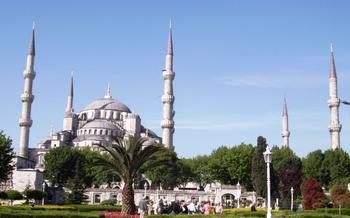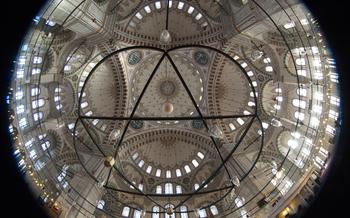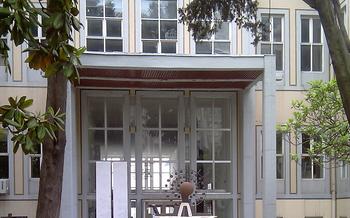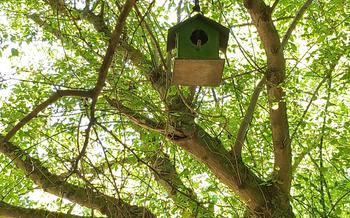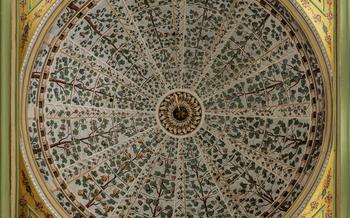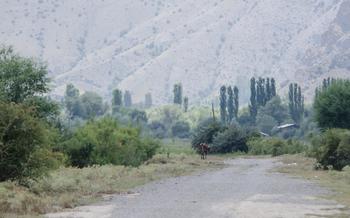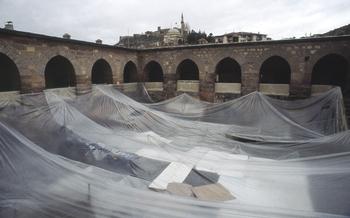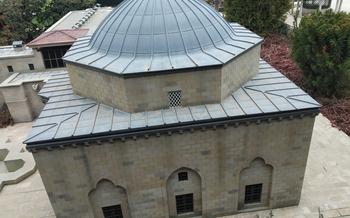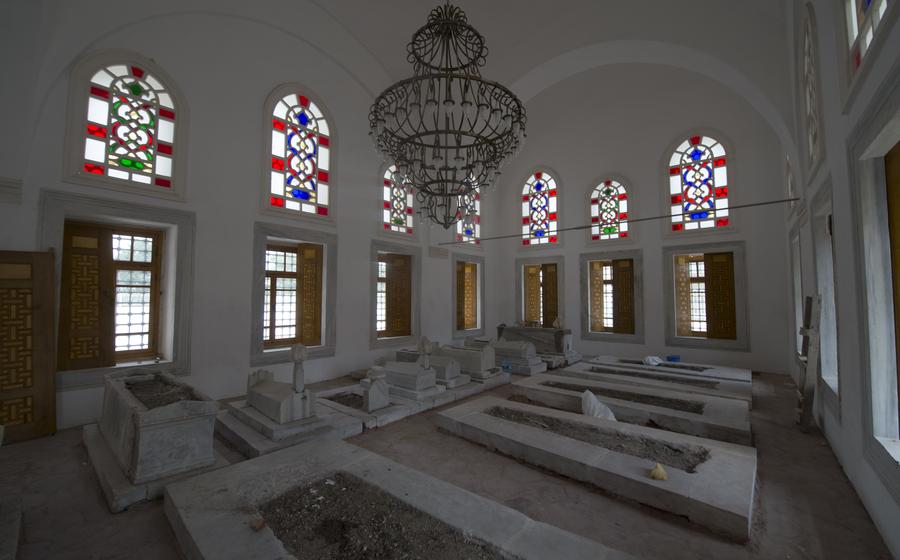
Süleymaniye Mosque
- The Süleymaniye Mosque: A Masterpiece of Ottoman Architecture
- A Journey Through Time: Exploring the Mosque's History
- Marveling at the Mosque's Architectural Splendor
- The Mosque's Enduring Legacy: A Symbol of Ottoman Power
- Immerse Yourself in Islamic Traditions: Attending Prayer Services
- The Süleymaniye Mosque: A Place of Serenity and Reflection
- Unveiling the Mosque's Hidden Treasures: Guided Tours
- Capturing the Mosque's Essence: Photography Tips
- The Süleymaniye Mosque Through the Eyes of History: Historical Accounts
- The Süleymaniye Mosque in Literature and Art: Cultural Depictions
- The Süleymaniye Mosque in Modern Times: Contemporary Significance
- Preserving the Legacy: Conservation and Restoration Efforts
- The Süleymaniye Mosque in the 21st Century: A Living Landmark
- Insider Tip: Unveiling the Mosque's Secret Garden
The Süleymaniye Mosque: A Masterpiece of Ottoman Architecture
The Süleymaniye Mosque stands as a testament to the grandeur and architectural prowess of the Ottoman Empire. Commissioned by Sultan Süleyman the Magnificent and designed by the renowned architect Mimar Sinan, the mosque was completed in 1557 after seven years of construction. It is considered one of the finest examples of Ottoman architecture, blending Islamic and Byzantine influences to create a masterpiece that has stood the test of time.
The Süleymaniye Mosque is a massive structure, with a central dome that reaches a height of 53 meters and four minarets that soar into the sky. The mosque's exterior is adorned with intricate stone carvings, while the interior is decorated with stunning tilework, calligraphy, and stained glass windows. The mosque also features a vast courtyard, a library, a hospital, and a soup kitchen, reflecting its role as a center of Islamic learning, charity, and community life.
The Süleymaniye Mosque was not just a religious building but also a symbol of the Ottoman Empire's power and wealth. It was built during the reign of Sultan Süleyman the Magnificent, when the empire was at its peak. The mosque's grand scale and opulent decoration were intended to showcase the empire's might and prestige.
Today, the Süleymaniye Mosque is one of Istanbul's most popular tourist attractions and a UNESCO World Heritage Site. It is open to visitors daily, and admission is free. Visitors can explore the mosque's vast interior, admire its stunning architecture, and learn about its rich history.
A Journey Through Time: Exploring the Mosque's History
The Süleymaniye Mosque stands as a testament to the grandeur and ambition of the Ottoman Empire. Its construction was commissioned by Sultan Süleyman the Magnificent, one of the empire's most powerful and influential rulers. The mosque's construction began in 1550 and was completed in 1557, a testament to the skill and dedication of the Ottoman architects and builders.
The mosque quickly became a center of Islamic learning and scholarship. It housed a vast library filled with thousands of volumes on various subjects, including theology, law, history, and science. The mosque's scholars and students made significant contributions to Islamic thought and culture, helping to spread knowledge and understanding throughout the empire.
Despite its grandeur and importance, the Süleymaniye Mosque has faced numerous challenges throughout its history. It has survived several earthquakes, fires, and wars, each time undergoing repairs and renovations to restore its former glory. The mosque's resilience is a testament to the dedication of its caretakers and the enduring legacy of the Ottoman Empire.
Over the centuries, the Süleymaniye Mosque has witnessed countless events, both joyous and tragic. It has been a place of prayer, celebration, and mourning, a stage for both personal and historical dramas. Its walls hold countless stories, waiting to be uncovered by curious visitors.
Marveling at the Mosque's Architectural Splendor
The Süleymaniye Mosque is a testament to the architectural prowess of the Ottoman Empire. Its awe-inspiring dome, towering minarets, and intricate tilework showcase the blending of Islamic and Byzantine influences. The mosque's vast courtyard, with its serene atmosphere and elegant arcades, invites visitors to pause and appreciate the grandeur of this architectural masterpiece.
The mosque's interior is equally impressive, adorned with exquisite tilework and calligraphy that narrate stories from the Quran and Islamic history. The central dome, rising high above the prayer hall, is a marvel of engineering and a symbol of the Ottoman Empire's architectural achievements. The mosque's vastness is amplified by the use of natural light, which filters through the stained-glass windows, casting a warm glow on the intricate details of the interior.
As I stood in the courtyard, marveling at the mosque's grandeur, I couldn't help but feel a sense of awe and wonder. The Süleymaniye Mosque is not just a place of worship; it is a testament to the creativity, skill, and artistry of the Ottoman Empire, a living symbol of its enduring legacy.
The Mosque's Enduring Legacy: A Symbol of Ottoman Power
The Süleymaniye Mosque stands as a testament to the Ottoman Empire's wealth, influence, and architectural prowess. Its sheer size and grandeur reflect the empire's vast power and resources, while its intricate details and exquisite craftsmanship showcase the Ottomans' commitment to aesthetics and their patronage of the arts.
During the Ottoman period, the mosque served as a symbol of the empire's religious and political authority. It was a place where the sultan and his court worshipped, and where important state ceremonies were held. The mosque's prominent location on the Third Hill of Istanbul, overlooking the city, further emphasized its symbolic significance as a focal point of the Ottoman capital.
The Süleymaniye Mosque's enduring legacy is evident in its status as a UNESCO World Heritage Site, a designation that recognizes its outstanding universal value and cultural significance. The mosque is a cherished landmark of Istanbul, attracting millions of visitors each year who come to admire its beauty and learn about its rich history. It remains a symbol of the Ottoman Empire's enduring influence and a source of pride for the Turkish people.
Immerse Yourself in Islamic Traditions: Attending Prayer Services
Attending prayer services at the Süleymaniye Mosque is a unique opportunity to immerse yourself in Islamic traditions and experience the spiritual essence of this sacred space. Before entering the mosque, it is essential to observe proper etiquette and customs. Women must cover their heads with a scarf or headscarf, while men should dress modestly. Once inside, remove your shoes and place them in the designated racks.
The mosque's vast prayer hall can accommodate thousands of worshippers, creating a powerful sense of community and unity. As the call to prayer echoes through the mosque, worshippers gather in rows, facing the qibla (the direction of Mecca). The imam, or prayer leader, stands at the front and leads the congregation through the various movements and recitations of the prayer.
Participating in Islamic prayers at the Süleymaniye Mosque is a deeply spiritual experience that allows visitors to connect with the local Muslim community and gain a deeper understanding of Islamic customs and traditions. Observe the worshippers around you, noting their devotion and reverence. It is a truly humbling and enriching experience that will leave a lasting impression.
Here are some anecdotes and insights from my personal experiences attending prayer services at the Süleymaniye Mosque:
-
During my first visit, I was struck by the sense of peace and tranquility that permeated the mosque. Despite the large number of worshippers, there was a palpable sense of serenity and devotion.
-
I was particularly moved by the imam's melodious voice as he recited the Quranic verses. His recitation was both beautiful and deeply moving, creating a powerful spiritual atmosphere.
-
After the prayers, I took some time to sit in the mosque and reflect on my experience. I felt a profound sense of gratitude for the opportunity to have participated in this sacred ritual and to have witnessed the deep faith of the Muslim community.
The Süleymaniye Mosque: A Place of Serenity and Reflection
Amidst the bustling streets of Istanbul, the Süleymaniye Mosque stands as an oasis of tranquility, inviting visitors to find solace and reflection within its sacred walls. The mosque exudes an aura of serenity that envelops all who enter, creating a sanctuary where one can escape the distractions of the outside world and connect with their spiritual self.
As you step inside the mosque, the vastness of the space and the intricate beauty of the architecture immediately instill a sense of awe and humility. The soaring dome, supported by elegant columns, creates a sense of spaciousness that encourages contemplation and introspection. The soft light filtering through the stained-glass windows casts a warm glow on the interior, creating an atmosphere conducive to prayer and meditation.
The Süleymaniye Mosque is more than just a place of worship; it is a living testament to the enduring power of Islamic spirituality and the pursuit of knowledge. The mosque's serene atmosphere invites visitors to slow down, reflect on their lives, and connect with their inner selves. Whether you are a Muslim worshipper seeking spiritual guidance or a traveler seeking a moment of peace and contemplation, the Süleymaniye Mosque is a place where you can find solace, inspiration, and a renewed sense of purpose.
In the tranquil courtyard of the mosque, visitors can find a secluded spot to sit and meditate, enjoying the gentle breeze and the sound of birdsong. The courtyard's lush gardens and serene water features create a peaceful oasis that invites visitors to linger and reflect on the beauty of creation.
For those seeking a deeper spiritual experience, the Süleymaniye Mosque offers a variety of opportunities for prayer and contemplation. Visitors can participate in the daily prayers led by the mosque's imam, or they can find a quiet corner to pray on their own. The mosque also offers guided tours that provide visitors with insights into the mosque's history, architecture, and spiritual significance.
Whether you are a devout Muslim or simply seeking a place of peace and tranquility, the Süleymaniye Mosque is a place where you can find solace, inspiration, and a renewed sense of purpose. Take a moment to step away from the hustle and bustle of daily life and immerse yourself in the serene atmosphere of this sacred space.
Unveiling the Mosque's Hidden Treasures: Guided Tours
Exploring the Süleymaniye Mosque with a knowledgeable guide is an enriching experience that unveils the mosque's hidden treasures and uncovers its fascinating stories. Guided tours offer a deeper understanding of the mosque's architectural intricacies, historical significance, and cultural importance.
Led by experienced guides, these tours take visitors on a journey through time, shedding light on the mosque's construction, its role in the Ottoman Empire, and its enduring legacy. Guides point out hidden details that might otherwise go unnoticed, such as intricate tilework, unique inscriptions, and architectural elements that hold symbolic meaning.
Beyond the main prayer hall, guided tours often include visits to lesser-known areas of the mosque complex, such as the courtyard, the library, and the mausoleum of Sultan Süleyman and his wife, Hürrem Sultan. These areas offer a glimpse into the mosque's multifaceted history and provide a deeper appreciation for its grandeur.
When choosing a guided tour, it is advisable to opt for reputable companies that employ knowledgeable and passionate guides. Look for tours that are tailored to your interests, whether you're interested in architecture, history, or Islamic art.
Guided tours of the Süleymaniye Mosque offer a unique opportunity to delve into the heart of this iconic landmark, gain insights into its rich history, and discover its hidden gems. Embrace the chance to explore this architectural masterpiece with a knowledgeable guide and unlock the secrets of one of Istanbul's most beloved treasures.
Capturing the Mosque's Essence: Photography Tips
As a travel and photography enthusiast, capturing the essence of the Süleymaniye Mosque through my lens was an exhilarating experience. Here are some tips and insights to help you capture stunning photographs of this architectural marvel:
- Best Angles and Vantage Points:
- For a comprehensive view of the mosque's grandeur, position yourself at the main courtyard, capturing the interplay of domes and minarets against the sky.
-
To highlight the mosque's intricate details, such as the tilework and calligraphy, zoom in from various angles, creating a series of captivating close-up shots.
-
Camera Settings and Techniques:
- Utilize a wide-angle lens to encompass the mosque's expansive architecture.
- Experiment with different shutter speeds to capture the dynamism of the surrounding environment, such as the movement of clouds or people.
-
Adjust your aperture to control the depth of field, creating a blurred background to accentuate the mosque's grandeur.
-
Personal Anecdotes and Experiences:
- During my visit, I discovered a hidden gem within the courtyard: a tranquil fountain adorned with intricate tilework. Capturing this detail added a unique perspective to my collection.
- Experimenting with different lighting conditions, I found that the golden hour, just before sunset, cast a warm and ethereal glow on the mosque's exterior, creating a magical atmosphere in my photographs.
The Süleymaniye Mosque Through the Eyes of History: Historical Accounts
Throughout history, the Süleymaniye Mosque has captivated travelers, scholars, and historians with its architectural splendor and cultural significance. Various historical accounts and descriptions offer unique perspectives on the mosque's grandeur and its place in Islamic architecture.
One of the earliest and most detailed accounts comes from Evliya Çelebi, a 17th-century Ottoman traveler who visited the mosque during its construction. Çelebi marvels at the mosque's vast size and intricate decorations, describing it as "a miracle of the age" and "a masterpiece of Islamic architecture."
Another notable account is provided by the French diplomat and traveler Jean de Thévenot, who visited Istanbul in the late 17th century. Thévenot praises the mosque's "noble and majestic" appearance, highlighting its impressive dome and minarets. He also notes the mosque's role as a center of Islamic learning and scholarship, stating that it houses a library containing "a great number of books in Arabic, Persian, and Turkish."
In the 19th century, the British writer and historian Edward Gibbon visited the Süleymaniye Mosque and was struck by its "solemn beauty" and "air of grandeur." Gibbon describes the mosque's interior as "spacious and lofty," with "a vast number of columns supporting a dome of extraordinary lightness and elegance."
These historical accounts provide valuable insights into the Süleymaniye Mosque's enduring significance and its impact on travelers and visitors throughout the centuries. They offer a glimpse into the mosque's architectural grandeur, its role as a center of Islamic learning, and its status as a symbol of Ottoman power and influence.
The Süleymaniye Mosque in Literature and Art: Cultural Depictions
The Süleymaniye Mosque's grandeur and historical significance have inspired numerous literary and artistic works. In literature, the mosque has been featured in novels, poems, and travelogues, each offering unique perspectives on its beauty and significance. Several renowned Turkish authors, including Orhan Pamuk and Elif Shafak, have included the mosque in their writings, using it as a backdrop for their stories and characters.
In art, the Süleymaniye Mosque has been depicted in paintings, drawings, and photographs by both local and international artists. The mosque's distinctive architecture and intricate details have made it a popular subject for artists, who have captured its essence through various artistic styles and techniques. The mosque's presence in literature and art reflects its deep cultural significance and its enduring impact on the Turkish imagination.
One notable literary work that features the Süleymaniye Mosque is Orhan Pamuk's novel "My Name Is Red." The novel, which is set in 16th-century Istanbul, includes a detailed description of the mosque's construction and its role in the Ottoman Empire. Pamuk's vivid portrayal of the mosque brings to life its grandeur and the historical context in which it was built.
Another example is Elif Shafak's novel "The Forty Rules of Love," which mentions the Süleymaniye Mosque as a place of spiritual retreat for one of the characters. Shafak's novel explores the themes of love, mysticism, and the search for meaning in life, and the mosque serves as a powerful symbol of these themes.
The Süleymaniye Mosque's presence in literature and art highlights its enduring cultural significance and its status as a symbol of Turkish history, architecture, and spirituality.
The Süleymaniye Mosque in Modern Times: Contemporary Significance
In the modern Turkish landscape, the Süleymaniye Mosque remains a cornerstone of both religious and cultural life. Its enduring significance lies in its ability to adapt to the changing times while maintaining its historical and spiritual essence. The mosque continues to serve as a place of worship and a hub for Islamic scholarship, attracting worshippers and visitors from around the world.
Beyond its religious significance, the Süleymaniye Mosque has become a symbol of Turkish heritage and a popular tourist destination. Its architectural grandeur and historical importance draw visitors from all walks of life, who come to marvel at its beauty and learn about its role in Ottoman history. The mosque's presence in the modern city of Istanbul serves as a reminder of the enduring legacy of the Ottoman Empire and its contributions to Islamic architecture and culture.
In recent years, the mosque has been at the forefront of initiatives promoting interfaith dialogue and cultural exchange. The Süleymaniye Mosque has hosted events and programs aimed at fostering understanding and cooperation between different religious and cultural communities. Through these initiatives, the mosque plays a vital role in promoting peace and harmony in a world often characterized by division and conflict.
As a living landmark, the Süleymaniye Mosque continues to evolve and adapt to the needs of the 21st century. While preserving its historical integrity, the mosque has embraced modern technologies and practices to enhance the visitor experience. From interactive digital displays to guided tours in multiple languages, the mosque strives to make its rich history and cultural significance accessible to a global audience.
The Süleymaniye Mosque stands as a testament to the enduring power of Islamic architecture and the resilience of Turkish culture. As it navigates the challenges of the modern world, the mosque remains a beacon of faith, a symbol of unity, and a source of inspiration for generations to come.
Preserving the Legacy: Conservation and Restoration Efforts
The Süleymaniye Mosque, a testament to the architectural prowess of the Ottoman Empire, has stood for centuries as a beacon of Islamic culture and heritage. However, the relentless passage of time, coupled with the inevitable wear and tear caused by natural disasters and human activity, has taken its toll on this majestic structure. Recognizing the urgent need to preserve this architectural masterpiece for generations to come, meticulous conservation and restoration efforts have been undertaken.
Over the years, the Süleymaniye Mosque has undergone several major restoration projects, each aimed at addressing specific areas of deterioration. These projects have involved the painstaking repair and reinforcement of the mosque's structural elements, including its iconic dome and minarets. Skilled artisans and craftsmen have worked tirelessly to restore the intricate tilework and calligraphy that adorn the mosque's interior, ensuring that these artistic treasures continue to captivate visitors with their vibrant colors and elegant designs.
One of the most significant challenges in preserving the Süleymaniye Mosque lies in the sheer scale and complexity of the structure. Its vast size and intricate architectural details require specialized expertise and a comprehensive approach to restoration. To ensure the authenticity and integrity of the restoration work, experts in Islamic architecture and conservation techniques collaborate closely, meticulously studying historical documents and employing traditional construction methods to maintain the mosque's original character.
The preservation of the Süleymaniye Mosque extends beyond its physical structure. It also encompasses the safeguarding of its cultural and spiritual significance. By preserving this sacred space, we not only honor the legacy of the Ottoman Empire but also ensure that future generations can continue to experience the mosque's profound spiritual and aesthetic impact.
The Süleymaniye Mosque in the 21st Century: A Living Landmark
In the ever-evolving landscape of the 21st century, the Süleymaniye Mosque stands as a testament to the enduring power of faith and cultural heritage. Adapting to the needs and challenges of modern times, the mosque has transcended its role as a religious center to become a symbol of interfaith dialogue and cultural exchange.
The mosque's vast courtyard and serene atmosphere provide a welcoming space for people of all backgrounds to come together, fostering understanding and mutual respect. Educational programs and events held at the mosque promote dialogue between different faiths, creating a platform for open and respectful conversations about shared values and beliefs.
Moreover, the Süleymaniye Mosque serves as a bridge between cultures, connecting the past with the present and the East with the West. Its architectural grandeur and historical significance attract visitors from around the world, who come to marvel at its beauty and learn about its rich history. Through tourism and cultural exchanges, the mosque plays a vital role in promoting understanding and appreciation of Islamic culture and heritage.
As the world continues to grapple with division and conflict, the Süleymaniye Mosque stands as a beacon of hope, demonstrating the power of faith and culture to bring people together. Its enduring legacy and ongoing relevance in the 21st century serve as a reminder of the importance of preserving and celebrating our shared heritage.
Insider Tip: Unveiling the Mosque's Secret Garden
In the heart of the Süleymaniye Mosque complex lies a hidden gem, a secret garden that offers visitors a tranquil oasis amidst the bustling city. Nestled between the mosque's towering walls and lush trees, this secluded retreat invites you to escape the crowds and immerse yourself in a serene and contemplative atmosphere.
To discover this hidden treasure, make your way to the courtyard of the mosque and look for a discreet doorway tucked away in a corner. Step through the doorway, and you will find yourself in a small, enclosed garden filled with vibrant flowers, aromatic herbs, and shady trees. The sound of trickling water from a nearby fountain adds to the tranquility of the space.
Take a moment to wander through the garden, admiring the colorful blooms and breathing in the fresh air. Find a secluded spot to sit down and simply be present, allowing the beauty of your surroundings to soothe your mind and spirit. Whether you come to seek solace, inspiration, or simply a moment of peace, the secret garden of the Süleymaniye Mosque is a sanctuary that invites you to connect with your inner self and appreciate the beauty of the natural world.
